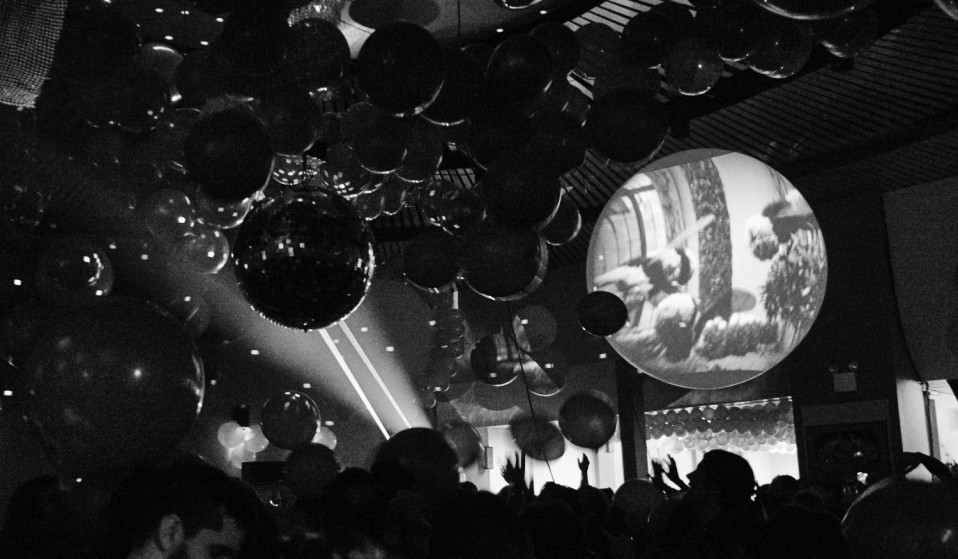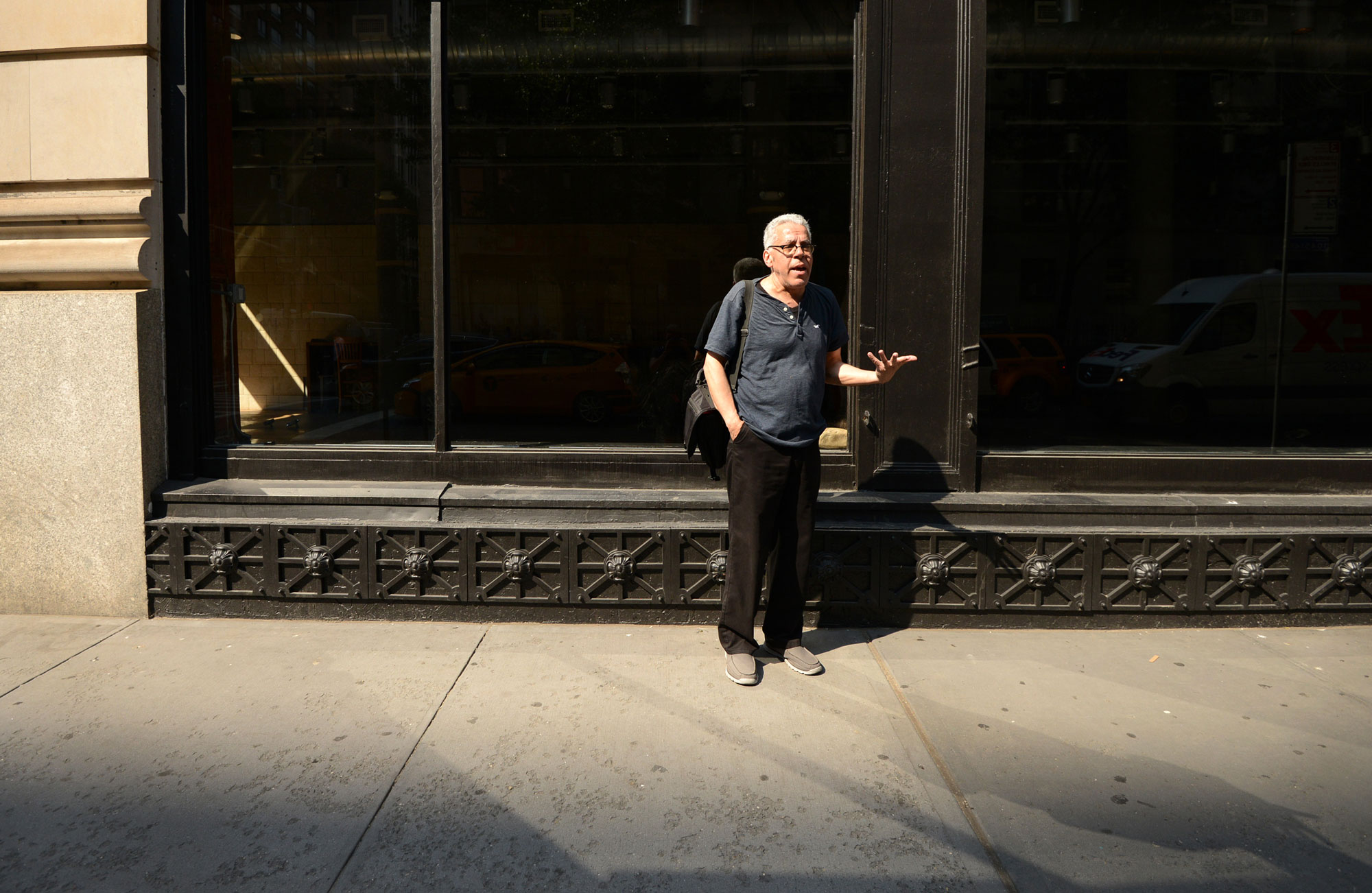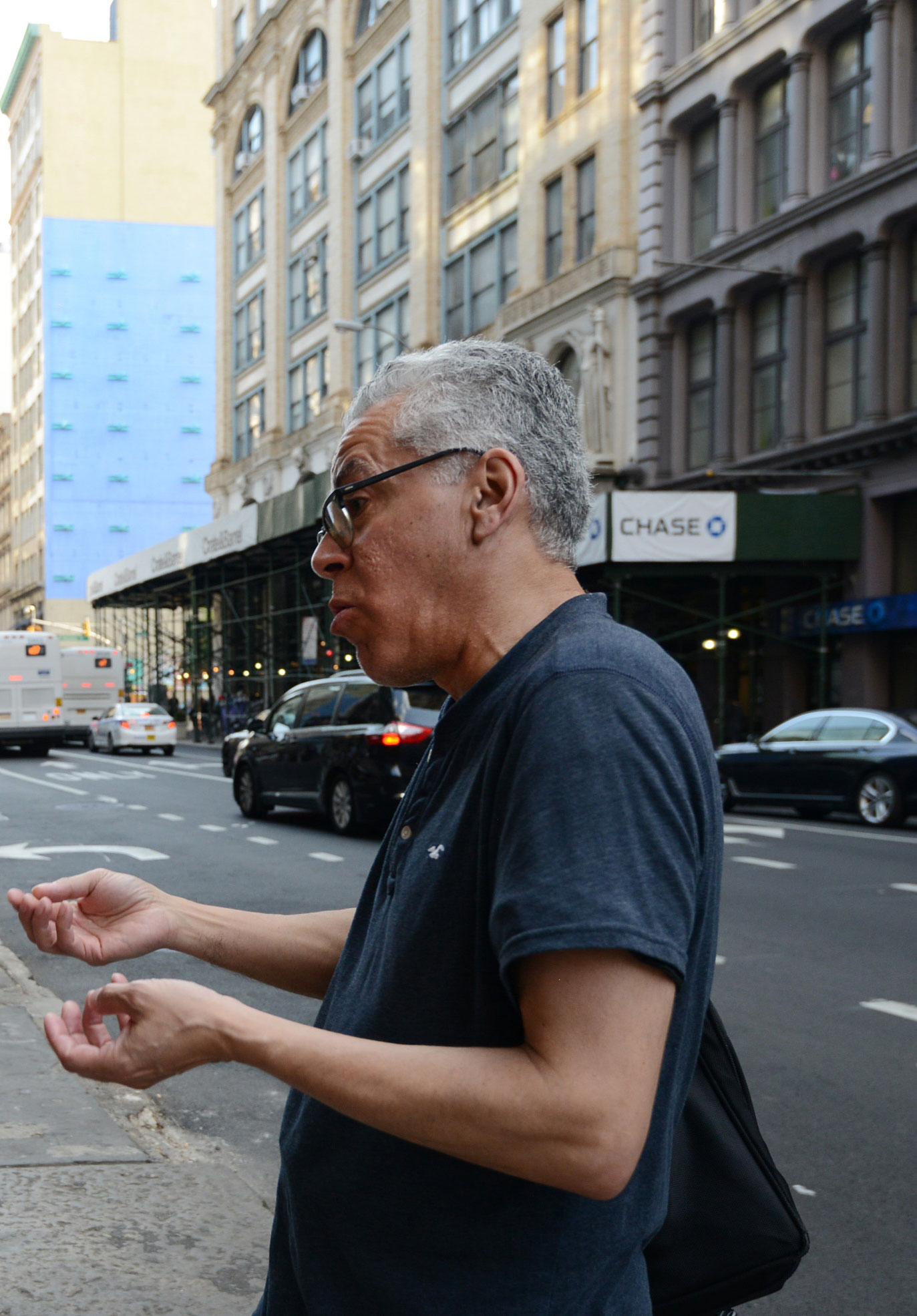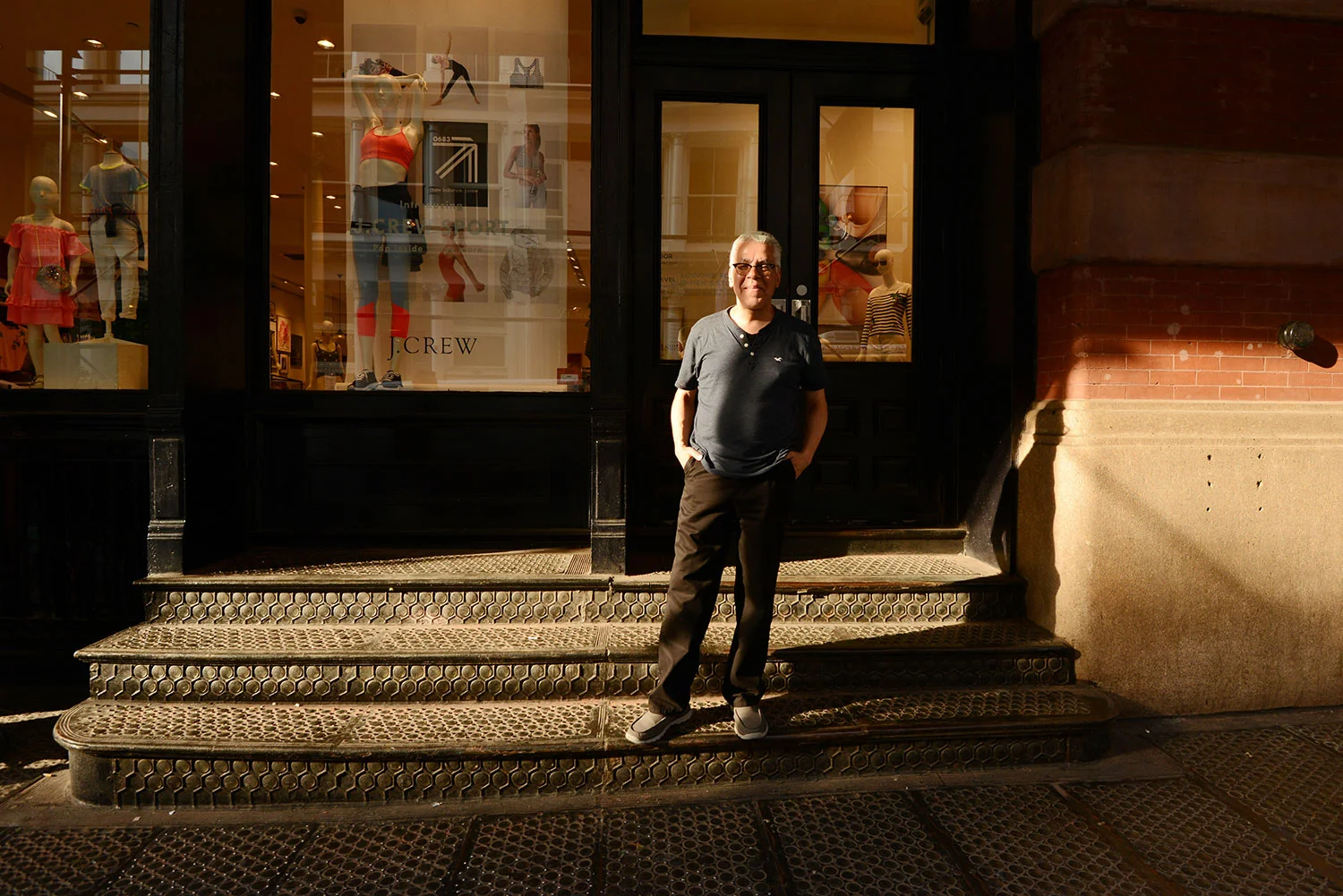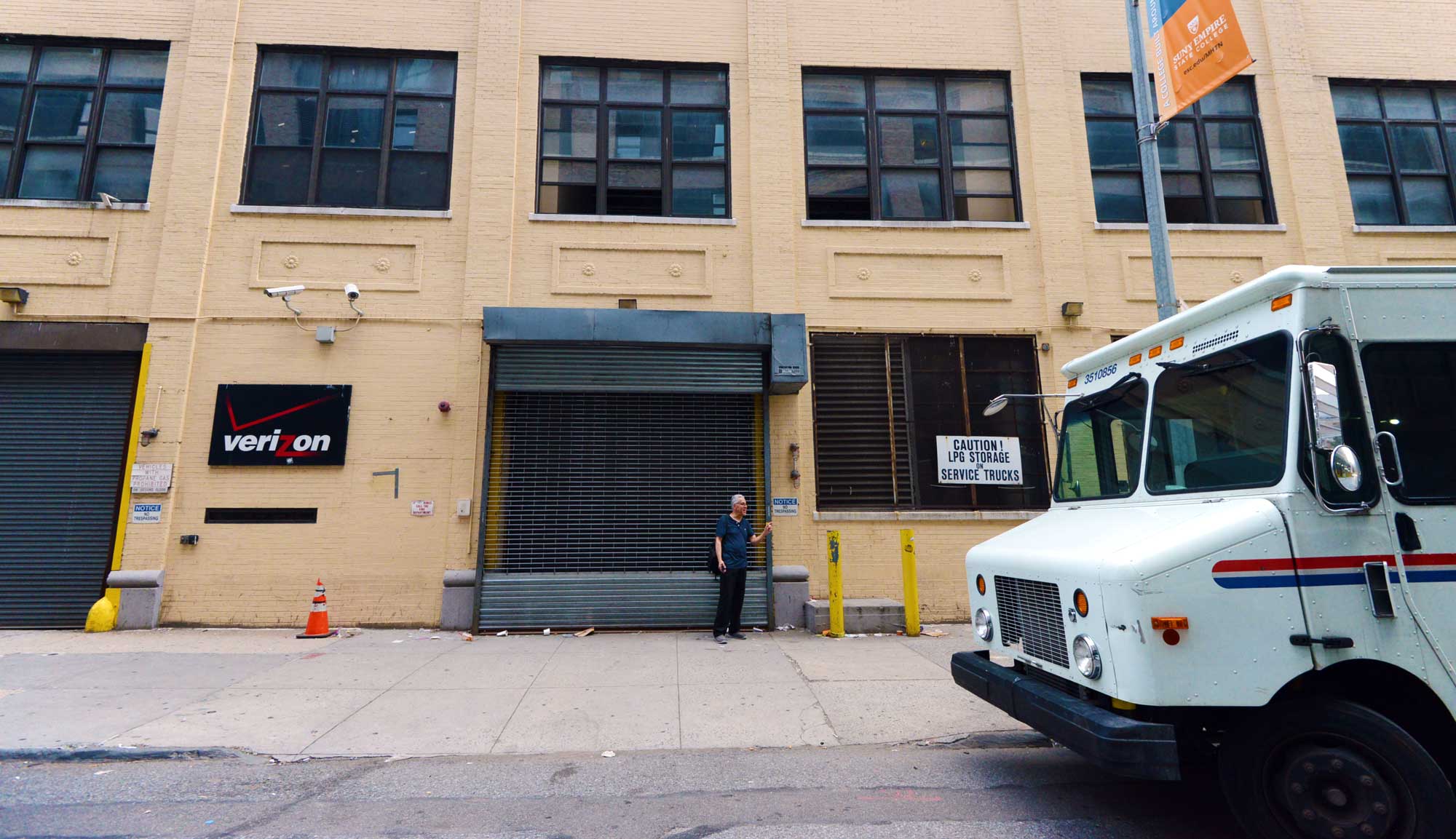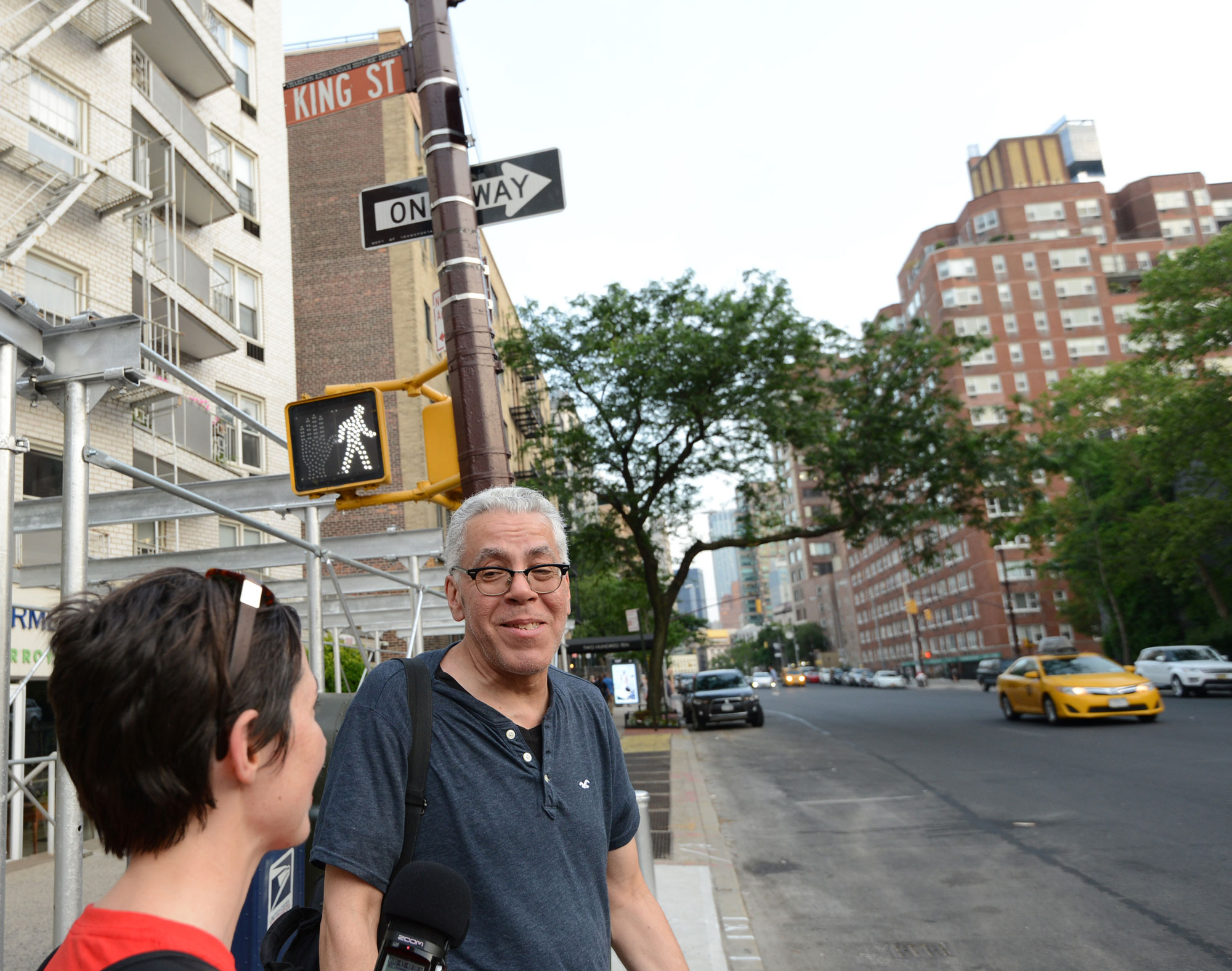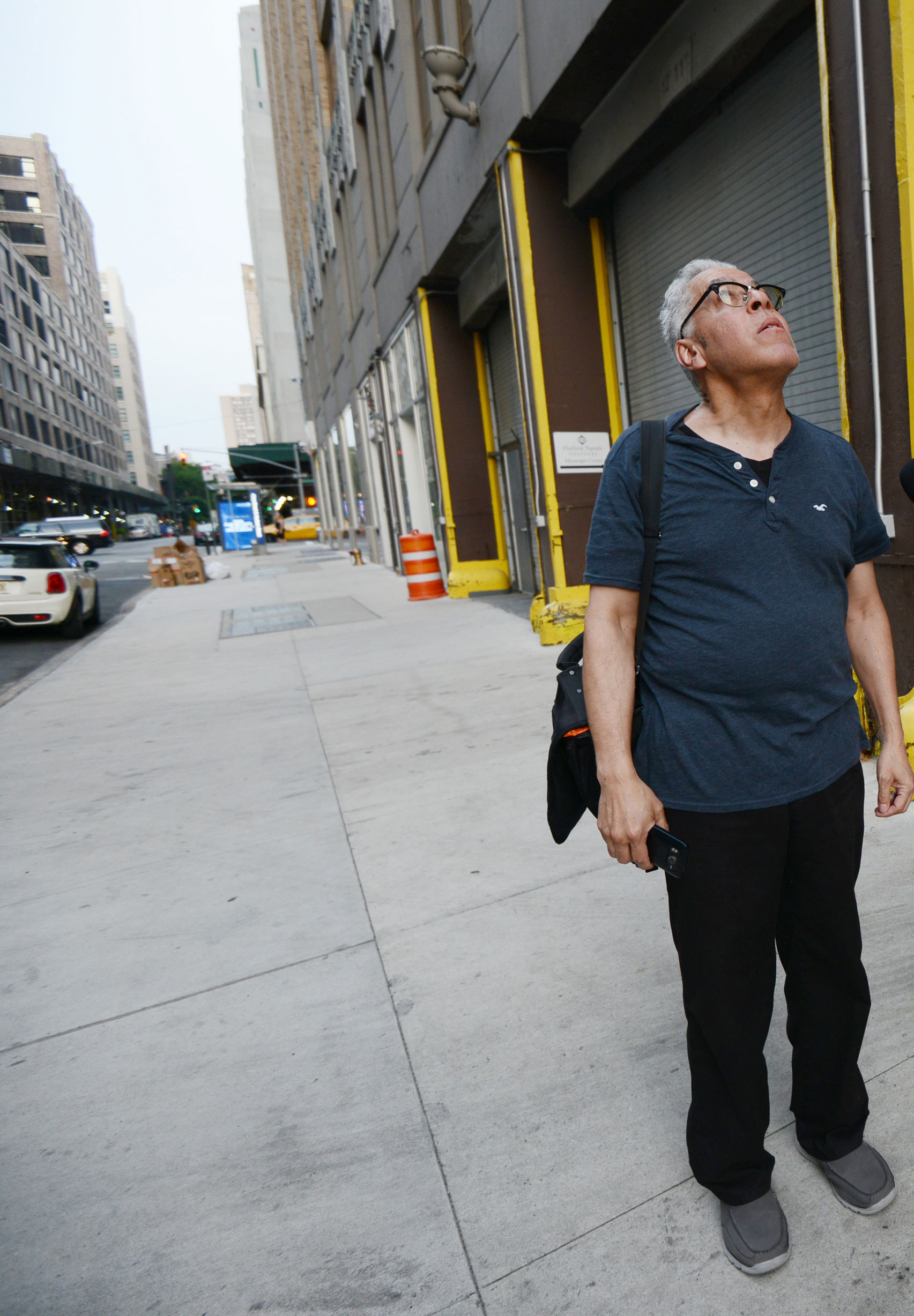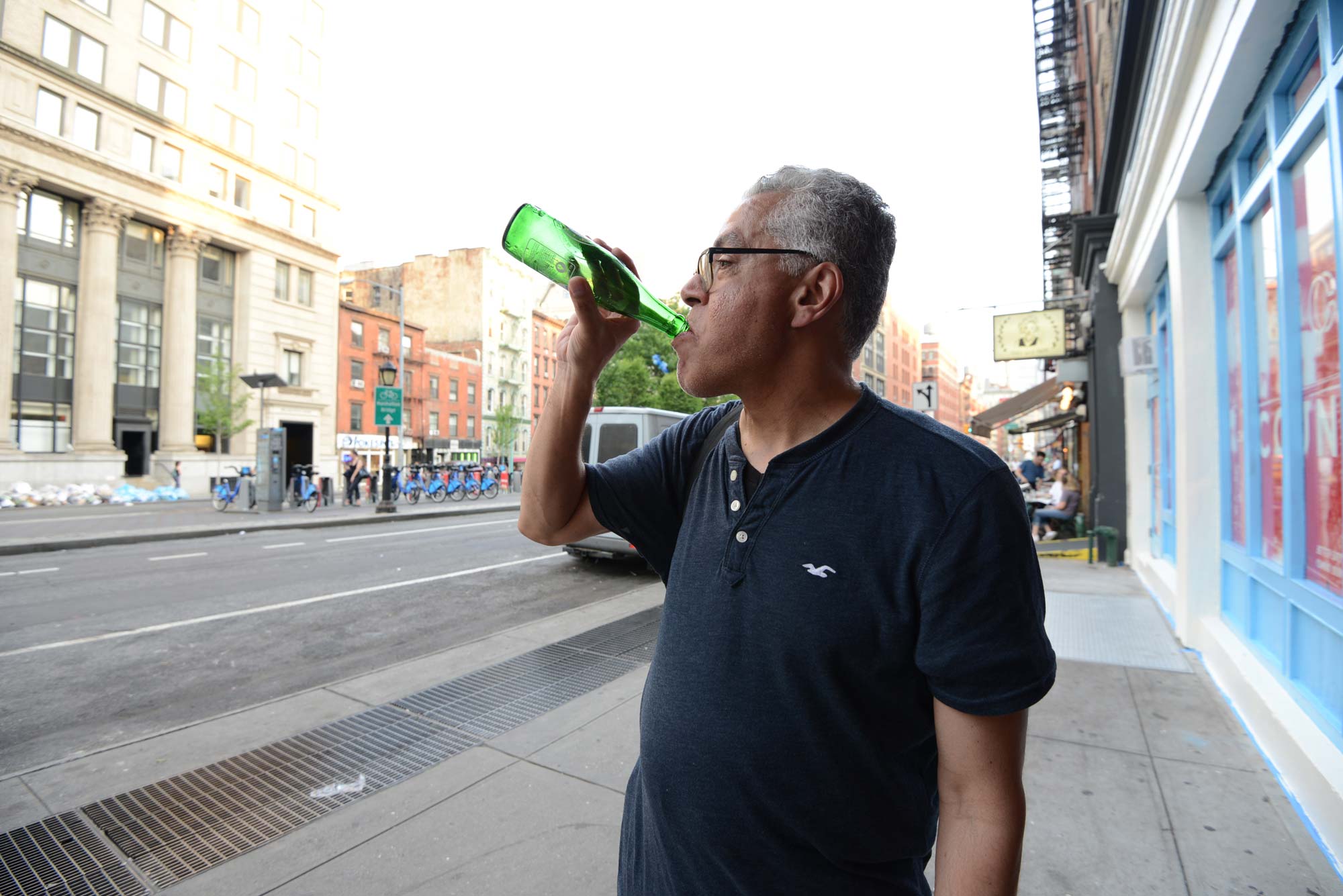'The reason you’re dancing today? That’s because of this place.'

Radio host Frank Ramos on the how the dance music clubs of seventies SoHo shaped our most intuitive form of storytelling
16 minute read
Words: Rosanna Vitiello & Allison Walker
Photography: Vanessa Ahlsborn
New York City's beat is electric and Frank Ramos is tapped right in. Frank’s love of dance music oscillates between encyclopaedic intellect and feverish enthusiasm. And it always had me hooked. Frank span into my life at downtown Brooklyn’s DeKalb Market, starting out as the 'guy next door' to BBOX — a community radio station founded to capture the borough's sounds and voices. Before long, our neighbor had blown our minds with his mastery of music, so one New Years Eve we handed Frank the turntables to take that passion on-air. Ever since, his shows Maximum Insight and Vibrations in Sound have taken listeners through the evolution of the world’s most eclectic dance music scenes. Frank's shows are like storytelling at its most vivid. They transport us to an edgier era, layering tracks, research and his native experience of New York's downtown clubs and record stores. So in a city now cleaned and commercialized beyond recognition, we take to the streets of SoHo with Frank to ask — if those effervescent times in Manhattan have faded, can dance music still take us there?
—
DJ culture didn’t start until the early 70’s. People like Dave Mancuso and Francis Grasso were the first to think, ‘Music does something to people and we want to try and communicate in some kind of narrative form how to get people inspired, through lyrical content.
—
But the 1970s was a turbulent time to come up in Manhattan. The economy had tanked and crime rates were through the roof. The streets of Soho welcomed artists, squatters and little else. But something was heating up. The Stonewall Riot of ’69 catalysed a revolution, and musical creation and artistic expression gave way to a fever of disco, dance music and club culture; a journey of self discovery when women’s liberation, gay emancipation and racial equality were mixing on the dance floor.
From unassuming origins, failing kids and falling buildings came together as the fledgling disco scene became common ground for New York counterculture, centered around now legendary outposts of sound like The LOFT and Paradise Garage. Young New Yorkers were escaping conservative parts of the city to find camaraderie in these clubs. DJ’s weren’t just hosting parties they were choreographing experiences that channeled New York’s energy into new scenes and forms of music — downtown roots that went on to influence dance music globally for generations.
Frank takes us on a tour to retrace his tracks and find the clandestine clubs that have left a mark on dance music’s memory. And as community was core to these scenes, our first stop is to meet fellow audiophiles — Ramsey Jones, a talented musician hailing from NYC’s influential WuTang family. And a surprise blast from the past — Steve Cohen, once a gatekeeper of East Village Radio and an original BBOX collaborator.
Frank Ramos and Ramsey Jones
Steve Cohen
LAND OF MAKE BELIEVE
Frank: Back in the 60’s clubs were discotheques based on a French ideal of what a club was. They had red velvet ropes; only people with money would go to these clubs. DJ’s were just like waiters - they played music to get people to drink. And they had tables - there wasn’t even any room for dancing!
DJ culture didn’t start until the early 70’s, with people like Dave Mancuso and Francis Grasso, when he was playing at the Sanctuary. They were the first people who thought about DJ’s being more than mere record players. They were the first people to think, ‘Music does something to people and we want to try and communicate in some kind of narrative form how to get people inspired, through lyrical content.’
David Mancuso’s Loft was his home. It was his house, and it was dead down here in the 70’s. But there was no sign, no bodyguard at the door, no one with a clipboard. He was a major component of what community was like in the club scene.
–
David Mancuso understood that people from all walks of life have a commonality, and he tapped into that.
–
He knew that from his upbringing as a foster kid. When he was a kid in the foster home, a nun named Sister Alicia used to have these parties for the kids with balloons and play records. David took on that theme as an adult. If you went to the LOFT, on the ceiling was a net, and there was nothing but balloons. And he did nothing but play records. It was David who really taught us to be open minded about music and the kind of community we wanted to be a part of. That mentality he brought to New York.
That’s the thing that we don't have now; now it’s too much of a niche thing, more a clique of self-centered groups. There’s not that access to community as there was before. It’s partly to do with the economics. You paid $5.99 to get in, and there was a jar full of pennies. Now, who can afford to have a place to go and hang out? The few clubs that exist now are high end.
Back then I went to clubs on word of mouth. It wasn’t like they were advertising for a particular demographic or group of people. I was living in Queens and I heard about the LOFT. And this is the thing that a lot of people don’t understand: a lot of credit goes to the Bronx for hip hop. But Brooklyn and Queens were also playing their part. The guys living in Queens told me about the LOFT and Paradise Garage. Back in the 60s and 70s there were local clubs, after-hours spots in the basements of the Bronx.
–
But going to Manhattan was a different experience. You were making that effort to go somewhere, and you were looking for that other thing.
–
Steve: In the ‘70s, if you found yourself at some alternative venue, you got there due to your own intrinsic interest. You needed to have a self-starting drive. What we didn’t have then was social media; you didn’t have inroads to information so a lot more was passed from person-to-person. So you would find yourself in a place where you had more in common with people, because their own curiosity brought them too.
Ramsey: A lot of those DJs not only made a place for people to create community, they also created sound systems that hit you in your soul, in your stomach. Reggae, back in the ‘60s they created sound systems; they wanted to be heard above others. They were competing against one another. These became state of the art.
That’s why the DJs were able to convey what the record is putting out there. That’s why music was such an integral part and the sound system also, to play music at its most primal — the loudness, the depth and the clarity. It hits you in a certain way, and that’s what they wanted to convey; they wanted to draw you in. People are so detached nowadays. Getting into this other environment, it brings people together: the core of the place, the way everything is integral.
–
You want to take people out of their reality and take them into this other world, that is not part of what we perceive as going through the city.
–
LIVING ON THE FRONTLINE
Frank: I was born in Manhattan; we were from Spanish Harlem originally, but before I was five we moved to Downtown Brooklyn. Fort Green, Lafayette, Atlantic Avenue, Brooklyn Tech. I saw myself in conflict with other people. I would listen to The Rolling Stones, and they’d say, ‘Why you listening to that white boy music?’ Ha!
Ramsey: I was born in Brownsville, Brooklyn. My family moved. At the time I was buying Jimi Hendrix, Rolling Stones. I listened to hip hop and disco but I loved other music. But a lot of my friends would tease me.
–
‘Why you listen to white boy music?’ Dude it’s music, it’s not white boy music, it’s music.
–
I had to go to a whole ‘nother area to get away from where I was at. So my father said, ‘Son, I can take you to the Village,’ because he worked for the MTA. He took me to West 4th Street, I went to Washington Square Park, and the whole vibe was different. Coming to the Village in the 80s was refreshing. There was such a sense of community and so much going on. Everyone was in close contact that was always a thing that was prominent. Especially working at Tower Records. People would come from a club and just hang out. Even in the 70’s, but around 1980 disco was dead -- like immediately dead. In the ‘80’s New Wave music was coming out. I was breakdancing around that time too. We would put on Dance to the Drummers Beat. I played in bands in the 90s and New York had that edge still.
Frank: Back in the ‘70s I went to the High School of Art and Design. I met this whole other world of people; they enriched me. I had my phonograph and I used to read serious books. We were conscious then of the people who were doing things. We knew they were rebels too, as writers, as performers….
Ramsey: Even the way I was dressing — I started wearing things around my neck because I idolized Hendrix. My friends couldn’t figure me out. They’d ask me, ‘Are you gay?’ Dude, no, I’m myself. I felt the need to get away, to see people who were like-minded.
–
After I left downtown Brooklyn, I never went back. Only once in a while. I can tell you right off the bat that AIDS took over my neighbourhood.
–
Frank: It was a crisis that really affected the city, and no one knew what it was. My very close friend Michael, who introduced me to the Loft and the Garage, was one of many along with his girlfriend Anna, who died of complications due to AIDS.
Ramsey: Not only AIDS, but crack. My whole neighbourhood changed. Around that time I had friends I went to school with that became drug dealers. In the 80s it devastated urban communities.
On the flip-side, in this city when you didn’t have much, people created out of not having. A lot of kids growing up in the neighbourhood I grew up in, they couldn’t get into clubs, so they created their own scene. And their own music. That’s how hip hop started. They were spinning records that had break-beats. A lot of the records at that time had breaks in them. So DJs would make the break longer by having two copies of the record. And at the time, it was only 45s, so they would find the break on the 45 and spin it back and forth. That gave a lot of ideas for people to create their own music, their own genres, and it spread all over New York. It was a really fertile scene.
WELCOME TO OUR WORLD
Frank: The whole point is that music was something that was being responded to. The whole underground, gay and disco scene, hip hop on the streets, Lower East Side, punk, New Wave. This place was a hotbed. And people would be on the street — they weren’t like superstars, you could meet any of these so-called famous people. They were living in the tenement buildings.
Pop artists today have a huge stage now that they didn’t have 20-30 years ago. They have access to people and fans have access to them. They’re so concerned that they’re going to come off being political. But you can say something if you really care. Pop has never been threatening, it’s always been safe music. We’re probably producing more music than in the history of existence!
Steve: In a way, now it’s all a diluted process. What’s changed is the money that has played such a role in the change of the neighborhoods and the almost virtual elimination of clubs and venues in Manhattan. When I was growing up there was a ritual aspect to music. It was something people did and they felt it to their core. That was probably the most important thing about it. Today, with technology and social media we are getting a much broader picture but perhaps we’re lacking depth.
–
Everything we’re talking about now — stories passed along from person to person, they were an important part of that experience.
–
Now there’s less record stores, but there’s an uptick -- most of it based in Brooklyn. Economically people just got pushed out of here. It’s not surprising that Trump is in power and from New York. There is no part of him that would ever care about any form of the arts — or humanity.
Like Frank said, there’s more music than there’s ever been. But there’s so many more people. With the radio, there were only so many places on the dial. With the internet as vast as it is, can we really have a ‘Local Legend’? My roommate was working on this film called ‘Downtown 81’. It focused on two things: Basquiat and the music scene. Basquiat liked my roommate John, so he gave him a piece. So the piece was on the wall at the wrap party. And hundreds of people came. Someone threw an egg at it, and the egg shell is still on it to this day. That’s a Local Legend story. It only really happens because people were able to respond to something original, different, and new. They had intuition as individuals.
Frank: There’s a bit of a fight in people that there used to be in the 1970s, except that New York is not in a state of bankruptcy, it’s in an opposite state — it’s thriving. But there is that angst again, a certain vibe going on. The whole real estate thing, the gentrification thing. It’s a different thing that’s motivating it, but I do see some sparks of people reacting and speaking up.
Ramsey: I was involved in a black theatre production at Lincoln Centre, around ‘83 or 84. I remember taking the 1 train to 65th Street. I got off the train and I saw this gentleman doing graffiti on the wall. I recognised his style, so I said, ‘Excuse me, are you Keith Haring?’ And he was like, ‘Yeah.’ That was New York. There was a such a sense of community and so much going on. Everyone was in close contact — that was always the thing that was prominent.
–
People are so comfortable now. You hear it in the music; it lacks visceral edge, it lacks danger.
–
It’s so watered down. There was so much underground music flowing that spoke about what’s going on to the world, the politics. We need more of that now. It’s so important that people need to speak up about what’s going on in the world.
WALKING IN RYTHMN
A tour of SoHo through the building blocks of disco
Dave Mancuso changed the face of the New York music scene. In the late 1960s and 1970s he opened up The LOFT, his home, to friends so they couldn't just listen to music, they could experience music in the most visceral way. He created an atmosphere rooted in generosity and openness, and the components were carefully composed — he invested in a groundbreaking bespoke sound system and synchronised lighting. He offered food and drink for free. His 12- to 14-hour sets were more like prolonged stories that unfolded based on the sentiments, lyrics, beats and rhythms of the records that he played. David Mancuso broke barriers by mixing classes and races at the very first house parties that set the template for every club that followed. So Frank reveals the history of the disco scene that influenced global dance music as we know it — a story embedded in the streets of SoHo.
The LOFT
647 Broadway
Frank: People wouldn’t know that this was the LOFT. A few years ago, they decided to name the block that Paradise Garage was on Larry Levan Way. At the time, I thought as great as Larry Levan was, really it was David Mancuso that deserves that much accolade and respect.
The first opening of the LOFT was on Valentine’s Day and it was called Love Saves the Day. It was by invite-only — he sent out postcards of the Little Rascals, a television show about poor kids. It was almost like a sense of the kid in you who didn’t get to have things. You created your own world out of what you had. He didn't call it the Loft; it became the Loft because it was a loft-like space, and people said, "We're going to the place, a loft in SoHo," and that's how it got the name. The people just named it that because that's what we recognized.
–
Mancuso understood as a foster child what it was like to feel abandoned. He also understood that there was a group of people out there like him who didn’t have a community yet.
–
These like-minded people hadn’t come across each other yet. He just had this foresight, it seems, that certain people of a particular background — he wanted to bring them together to hang out at his home. He was influenced by Sister Alicia (who threw parties in the children’s home), and Timothy Leary’s LSD parties in LA. The punch bowl at the LOFT was sometimes spiked with just that, but regulars knew to ask and tell newcomers.
He was the kind of individual that if you didn't have anywhere to go, you could stay there. You know what was so great? The loyalty to him. At the end of the night, he had almost staff of people. These people came, they cleaned up, they made sure the place was nice and clean. The people who stood there, they were homeless. Sometimes they were kids who ran away from home, and they stayed there for a while.
Frank Ramos in front of what once was The LOFT, 99 Prince Street, Ground and second floor
The LOFT
99 Prince Street
This place was iconic. This is the location of the Loft that was really popular. Where he built his sound system. This is where people like me went during ‘75, ‘76, ‘77.
At ten o-clock at night, there were people standing out here, waiting to get in. We went in at the freight entrance and it was up on the second floor. There would be somebody at the counter, and you would pay $5.99. The penny would go in a jar, and you were in.
There were incredible dancers doing freestyle, ballet and jazz and innovative stuff. His palate was so wide-ranging and of high quality. The environment, the sound system, and the space — he created an atmosphere and a vibe where people could come and be themselves.
–
He invited people he knew who were outcasts; he embraced the gay/black scene, latinos. He embraced the marginalised.
–
My friend Michael in Queens told me, ‘Frank, I'm going to this place called the LOFT. I have to take you.’ He knew I loved music. We all loved music. That was one of the reasons we hung out together. I said, 'Man, I would love to go.' He took me one night. I remember standing outside waiting to get in. I had no idea where I was going, but I remember being totally fascinated by the fact that here was a place where people like me were in there. Everybody was just into their own world.
You could go in, you could smoke your weed, you could sit in a corner and mind your own business, you could listen to music and since I loved music, this was a man who was playing music I have never heard of. He was known for introducing people to music. That was his thing.
–
He understood music and it was important for him that you heard it in its purest form. I got a lot of that from him. He taught us. People called him like a father to many.
–
84 King Street, former Paradise Garage
Paradise Garage
84 King Street
They want to rename King Street Larry Levan Way — and there it is. Every year they have a party for him. He’s the most influential DJ of that era, but he wasn’t only a DJ, he produced a lot of records. He was prolific like that. What was advantageous to him, he had two things: He knew how to produce records that people would dance to in a club. And he had a musician's ear, he understood what the crowd reacted to. And of course he could bring it to Paradise Garage and play it.
I remember the first time I went. I had never been inside. I standing outside and I’m hearing the music. And I never heard bass like that in — my — life. I’m standing by the door. You can’t see it — but you can feel it. You knew this was going to be something different from anything you’d ever seen before. You’d get your ticket from the booth, just like the booth in the parking garage. As you’re going inside the building you’re going up the ramp of the garage. It was like going into a flying saucer, and there was a neon sign that was very famous, a guy with a tattoo and a muscle. But you didn’t walk straight onto the dance floor. They had a door.
–
I remember standing on the corner; I was astounded. I stood there for a few minutes — I had to take it in before I entered. And it was a huge space. There was nothing but people. I had to wait a second before I became a part of this.
–
You know another thing that was interesting? No dress code. The outfit was shorts and a t-shirt — if that much! The guys, especially the gay guys, danced in their shorts; they definitely didn’t dance in their t-shirts. Maybe they took off their shoes.
Then you could check your coat and you could change into your shorts! And you could dance. It would be body to body. It was dark. That was purposeful. Levan broke rules. You can turn off all the lights you wanted, but but not exit lights. But Levan was crazy, he did that. All you could feel was people and hear music.
For all his greatness, he was such a drug user, a major indulger. No question. He would pass out sometime on the turntable. A record would skip sometimes for 15, 20 minutes. He was the only DJ who could get away with that.
No Goodbyes
The LOFT never actually died. What happened was economics. After the 1980s, once people started moving into SoHo. This wasn't even called SoHo at that time, that’s a real estate thing. There was no such thing as SoHo. That was after real estate people started to bring people and the population started to change. What happens is that the rent became too high and you can't afford to stay anywhere long. So as far as the Loft in that world in New York is concerned.
New York had a certain reputation. It was this cultural hotbed. New York went international. The reason why you’re dancing today is because of this place.
Why did the 12 inch record stay in business? Because of dance music.
The city changed, but dance music kept going anyway.







